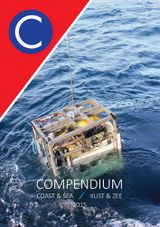|
|
| (96 intermediate revisions by 3 users not shown) |
| Line 1: |
Line 1: |
| − | ==Bathymetry from inverse wave refraction== | + | <div style="float:right; margin-left:10px; margin-top:5px">[[File:Compendiumcoastandsea.jpg|160px|right|link=Compendium for Coast and Sea - creating a marine science-policy interface]]</div> |
| − | | + | '''Compendium for Coast and Sea - creating a marine science-policy interface''' |
| − | [[Image:01_echosoundings_enc.jpg|thumb|350px|right|Bathymetry of area of investigation acquired by multibeam echosounder.]] | + | <p style="margin-top:-15px"><br/></p> |
| − | | + | The Compendium for Coast and Sea is an integrated knowledge document about the socio-economic, environmental and institutional aspects of the coast and sea in Flanders and Belgium. As such, it constitutes a one-stop shop for data and information from the Flemish and Belgian marine and maritime research community and experts. The Compendium for Coast and Sea is an initiative of the Flanders Marine Institute (VLIZ) and was developed in close collaboration with experts from the research community, government, industry and civil society organisations. The first version of the Compendium was launched in 2013, a second edition was presented in 2015. |
| − | It is possible to determine the [[bathymetry]] of a certain area using radar data. On the Island of Sylt at the German Bight Coast, measurements are done during storm conditions. This data is processed based on inversion of the non-linear and linear wave theory. More about the area of investigation, data processing, result and discussion of the results can be found in the article.
| + | </div> |
| − | | |
| − | The determination of the [[bathymetry]] in coastal environments by utilizing the ocean wave-shoaling photographic imagery, and the observed reduction of ocean wave phase speed with decreased water depth, is used since the WW-II (Williams 1946)<ref>Williams, W.W. 1946, The determination of gradients of enemy-held beaches. Geographical Journal 107, 76–93.</ref>. The last decade, with the expansion of different ground based instrumentations, mainly radar and video imagery, for the observation of the sea surface and the exponential increase of the computational power, several methodologies for the [[bathymetry]] reckoning have been published. The core of the previously mentioned methods is the inversion of the wave characteristics by assuming the validity of linear or non-linear models for the propagation of the wavefield over uneven sea bottom.
| |
| − | | |
| − | In the present investigation, twelve hourly radar datasets acquired during storm conditions are analyzed by two methods: The non-linear method of Bell et al. 2004<ref name="bell"/> (henceforth BW04), which is based on the inversion of the non-linear [[Dispersion (waves)|wave dispersion]] equation of Hedges (1976)<ref>Hedges, T.S. 1976, An empirical modification to linear wave theory, Proc. Inst. Civ. Eng., 61, pp. 575-579.</ref> and the Dispersive Surface Classificator (henceforth DiSC08), Senet et al. 2008<ref name="sen"/>, which is based on the inversion of the linear wave theory. The results are validated as bathymetric retrieving instruments and the two wave propagation theories are compared about their sensitivity to the local bathymetric relief. The two methods are compared under the assumption of fundamentally similar implemented algorithms.
| |
Latest revision as of 14:52, 8 April 2016
Compendium for Coast and Sea - creating a marine science-policy interface
The Compendium for Coast and Sea is an integrated knowledge document about the socio-economic, environmental and institutional aspects of the coast and sea in Flanders and Belgium. As such, it constitutes a one-stop shop for data and information from the Flemish and Belgian marine and maritime research community and experts. The Compendium for Coast and Sea is an initiative of the Flanders Marine Institute (VLIZ) and was developed in close collaboration with experts from the research community, government, industry and civil society organisations. The first version of the Compendium was launched in 2013, a second edition was presented in 2015.
